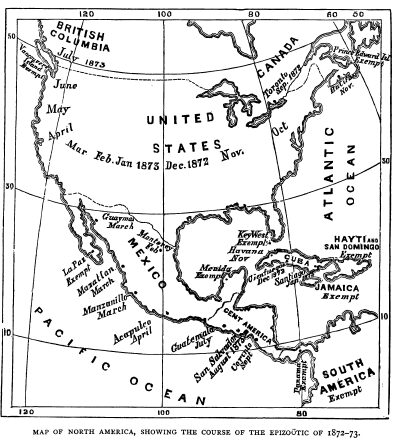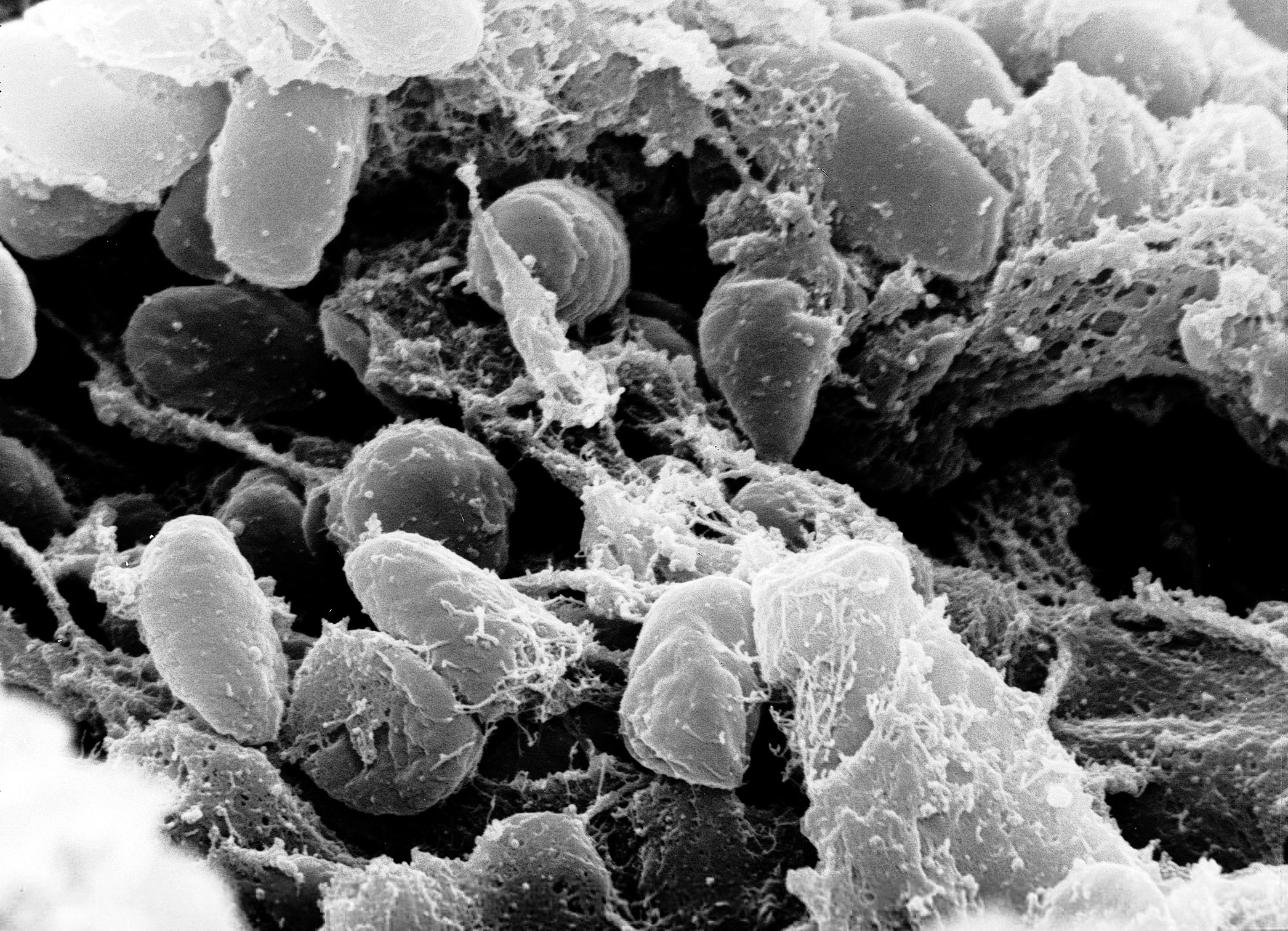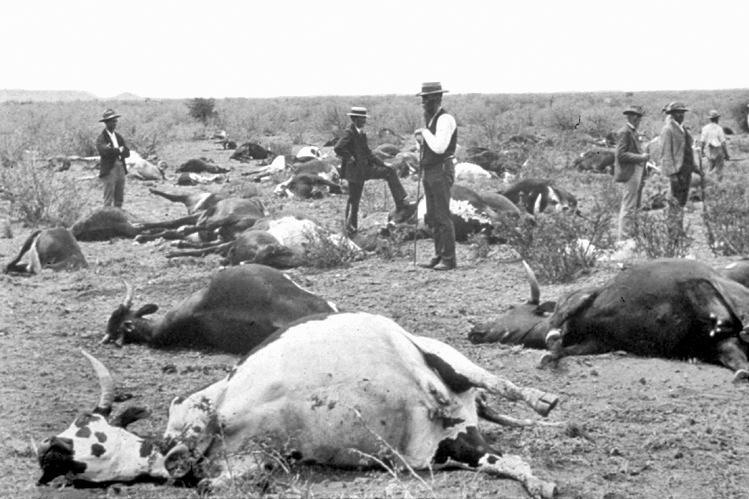|
Epizootic
In epizoology, an epizootic (from Greek: ''epi-'' upon + ''zoon'' animal) is a disease event in a nonhuman animal population analogous to an epidemic in humans. An epizootic may be restricted to a specific locale (an "outbreak"), general (an "epizootic"), or widespread ("panzootic"). High population density is a major contributing factor to epizootics. Aquaculture is an industry sometimes plagued by disease because of the large number of fish confined to a small area. Defining an epizootic can be subjective; it is based upon the number of new cases in a given animal population, during a given period, and must be judged to be a rate that substantially exceeds what is expected based on recent experience (''i.e.'' a sharp elevation in the incidence rate). Because it is based on what is "expected" or thought normal, a few cases of a very rare disease (like a transmissible spongiform encephalopathy outbreak in a cervid population) might be classified as an "epizootic", while many ca ... [...More Info...] [...Related Items...] OR: [Wikipedia] [Google] [Baidu] |
Equine Influenza
Equine influenza (horse flu) is the disease caused by strains of influenza A that are enzootic in horse species. Equine influenza occurs globally, previously caused by two main strains of virus: equine-1 (H7N7) and equine-2 (H3N8). The OIE now considers H7N7 strains likely to be extinct since these strains have not been isolated for over 20 years. Predominant international circulating H3N8 strains are Florida sublineage of the American lineage; clade 1 predominates in the Americas and clade 2 in Europe. (Elton and Cullinane, 2013; Paillot, 2014; Slater et al., 2013). The disease has a nearly 100% infection rate in an unvaccinated horse population with no prior exposure to the virus. While equine influenza is historically not known to affect humans, impacts of past outbreaks have been devastating due to the economic reliance on horses for communication (postal service), military (cavalry), and general transportation. In modern times, though, the ramifications of equine influenza are ... [...More Info...] [...Related Items...] OR: [Wikipedia] [Google] [Baidu] |
Aquaculture
Aquaculture (less commonly spelled aquiculture), also known as aquafarming, is the controlled cultivation ("farming") of aquatic organisms such as fish, crustaceans, mollusks, algae and other organisms of value such as aquatic plants (e.g. lotus). Aquaculture involves cultivating freshwater, brackish water and saltwater populations under controlled or semi-natural conditions, and can be contrasted with commercial fishing, which is the harvesting of wild fish. Mariculture, commonly known as marine farming, refers specifically to aquaculture practiced in seawater habitats and lagoons, opposed to in freshwater aquaculture. Pisciculture is a type of aquaculture that consists of fish farming to obtain fish products as food. Aquaculture can also be defined as the breeding, growing, and harvesting of fish and other aquatic plants, also known as farming in water. It is an environmental source of food and commercial product which help to improve healthier habitats and used to recon ... [...More Info...] [...Related Items...] OR: [Wikipedia] [Google] [Baidu] |
Enzootic
Enzootic is the non-human equivalent of endemic and means, in a broad sense, "belonging to" or "native to", "characteristic of", or "prevalent in" a particular geography, race, field, area, or environment; native to an area or scope. It also has two specific meanings: * an organism being "''enzootic''" means native to a place or a specific fauna * in epizoology, an infection is said to be "''enzootic''" in a population when the infection is maintained in the population without the need for external inputs (''cf''. Endemic). See also *Epizootic In epizoology, an epizootic (from Greek: ''epi-'' upon + ''zoon'' animal) is a disease event in a nonhuman animal population analogous to an epidemic in humans. An epizootic may be restricted to a specific locale (an "outbreak"), general (an "epi ... Biodiversity {{Veterinary-med-stub ... [...More Info...] [...Related Items...] OR: [Wikipedia] [Google] [Baidu] |
Enzootic
Enzootic is the non-human equivalent of endemic and means, in a broad sense, "belonging to" or "native to", "characteristic of", or "prevalent in" a particular geography, race, field, area, or environment; native to an area or scope. It also has two specific meanings: * an organism being "''enzootic''" means native to a place or a specific fauna * in epizoology, an infection is said to be "''enzootic''" in a population when the infection is maintained in the population without the need for external inputs (''cf''. Endemic). See also *Epizootic In epizoology, an epizootic (from Greek: ''epi-'' upon + ''zoon'' animal) is a disease event in a nonhuman animal population analogous to an epidemic in humans. An epizootic may be restricted to a specific locale (an "outbreak"), general (an "epi ... Biodiversity {{Veterinary-med-stub ... [...More Info...] [...Related Items...] OR: [Wikipedia] [Google] [Baidu] |
Epizoology
Epizootiology, epizoology, or veterinary epidemiology is the study of disease patterns within animal populations. See also * Epizootic * Epidemiology Epidemiology is the study and analysis of the distribution (who, when, and where), patterns and determinants of health and disease conditions in a defined population. It is a cornerstone of public health, and shapes policy decisions and evidenc ... References Epidemiology Veterinary medicine {{Veterinary-med-stub ... [...More Info...] [...Related Items...] OR: [Wikipedia] [Google] [Baidu] |
Panzootic
A panzootic (from Greek παν all + ζόιον animal) is an epizootic (an outbreak of an infectious disease of animals) that spreads across a large region (for example a continent), or even worldwide. The equivalent in human populations is called a pandemic. A panzootic can start when three conditions have been met: * the emergence of a disease new to the population. * the agent infects a species and causes serious illness. * the agent spreads easily and sustainably among animals. A disease or condition is not a panzootic merely because it is widespread or kills a large number of animals; it must also be infectious. For example, cancer is responsible for a large number of deaths but is not considered a panzootic because the disease is, generally speaking, not infectious. Unlike an epizootic, a panzootic covers all or nearly all species over a large surface area (ex. rabies, anthrax). Typically an enzootic or an epizootic, or their cause, may act as a potential preparatory facto ... [...More Info...] [...Related Items...] OR: [Wikipedia] [Google] [Baidu] |
Epizoology
Epizootiology, epizoology, or veterinary epidemiology is the study of disease patterns within animal populations. See also * Epizootic * Epidemiology Epidemiology is the study and analysis of the distribution (who, when, and where), patterns and determinants of health and disease conditions in a defined population. It is a cornerstone of public health, and shapes policy decisions and evidenc ... References Epidemiology Veterinary medicine {{Veterinary-med-stub ... [...More Info...] [...Related Items...] OR: [Wikipedia] [Google] [Baidu] |
Panzootic
A panzootic (from Greek παν all + ζόιον animal) is an epizootic (an outbreak of an infectious disease of animals) that spreads across a large region (for example a continent), or even worldwide. The equivalent in human populations is called a pandemic. A panzootic can start when three conditions have been met: * the emergence of a disease new to the population. * the agent infects a species and causes serious illness. * the agent spreads easily and sustainably among animals. A disease or condition is not a panzootic merely because it is widespread or kills a large number of animals; it must also be infectious. For example, cancer is responsible for a large number of deaths but is not considered a panzootic because the disease is, generally speaking, not infectious. Unlike an epizootic, a panzootic covers all or nearly all species over a large surface area (ex. rabies, anthrax). Typically an enzootic or an epizootic, or their cause, may act as a potential preparatory facto ... [...More Info...] [...Related Items...] OR: [Wikipedia] [Google] [Baidu] |
Sylvatic Plague
Sylvatic plague is an infectious bacterial disease caused by the plague bacterium (''Yersinia pestis'') that primarily affects rodents, such as prairie dogs. It is the same bacterium that causes bubonic and pneumonic plague in humans. Sylvatic, or sylvan, means 'occurring in woodland,' and refers specifically to the form of plague in rural wildlife. Urban plague refers to the form in urban wildlife. It is primarily transmitted among wildlife through flea bites and contact with infected tissue or fluids. Sylvatic plague is most commonly found in prairie dog colonies and some mustelids, like the black-footed ferret. Transmission vector The flea that feeds on prairie dogs and other mammals serves as the vector for transmission of sylvatic plague to the new host, primarily through flea bites, or contact with contaminated fluids or tissue, through predation or scavenging. Humans can contract plague from wildlife through flea bites and handling animal carcasses. Epidemiology and dist ... [...More Info...] [...Related Items...] OR: [Wikipedia] [Google] [Baidu] |
Wildlife Disease
Wild animals, domestic animals and humans share a large and increasing number of infectious diseases, known as zoonoses. The continued globalization of society, human population growth, and associated landscape change further increase the interactions between humans and other animals, thereby facilitating additional infectious disease emergence. Contemporary diseases of zoonotic origin include SARS, Lyme disease and West Nile virus. Disease emergence and resurgence in populations of wild animals are considered an important topic for conservationists, as these diseases can affect the sustainability of affected populations and the long-term survival of some species. Examples of such diseases include chytridiomycosis in amphibians, chronic wasting disease in deer, white-nose syndrome, in bats, and devil facial tumour disease in Tasmanian devils. Prevention Culling Disease outbreaks in wild animals are sometimes controlled by killing infected individuals to prevent transmission ... [...More Info...] [...Related Items...] OR: [Wikipedia] [Google] [Baidu] |
1890s African Rinderpest Epizootic
In the 1890s, an epizootic of the rinderpest virus struck Africa, considered to be "the most devastating epidemic to hit southern Africa in the late nineteenth century". It killed more than 5.2 million cattle south of the Zambezi, as well as domestic oxen, sheep, and goats, and wild populations of buffalo, giraffe, and wildebeest. This led to starvation resulting in the death of an estimated third of the human population of Ethiopia and two-thirds of the Maasai people of Tanzania. The famine significantly depopulated sub-Saharan Africa, allowing thornbush to colonise. This formed ideal habitat for tsetse fly, which carries sleeping sickness, and is unsuitable for livestock. The virus is thought to have been introduced into Eritrea in 1887 by Indian cattle brought by the Italians for their campaign against Somalia. It spread throughout the Horn of Africa, and crossed the Zambezi in March 1896. Sir Arnold Theiler Sir Arnold Theiler KCMG (26 March 1867 – 24 July 1936) Pou ... [...More Info...] [...Related Items...] OR: [Wikipedia] [Google] [Baidu] |
Viral Hemorrhagic Septicemia
Viral hemorrhagic septicemia (VHS) is a deadly infectious fish disease caused by Viral hemorrhagic septicemia virus. It afflicts over 50 species of freshwater and marine fish in several parts of the Northern Hemisphere. Different strains of the virus occur in different regions, and affect different species. There are no signs that the disease affects human health. VHS is also known as Egtved disease, and the virus as Egtved virus. Historically, VHS was associated mostly with freshwater salmonids in western Europe, documented as a pathogenic disease among cultured salmonids since the 1950s. Today it is still a major concern for many fish farms in Europe and is therefore being watched closely by the European Community Reference Laboratory for Fish Diseases. It was first discovered in the US in 1988 among salmon returning from the Pacific in Washington state. This North American genotype was identified as a distinct, more marine-stable strain than the European genotype. VHS has sinc ... [...More Info...] [...Related Items...] OR: [Wikipedia] [Google] [Baidu] |




